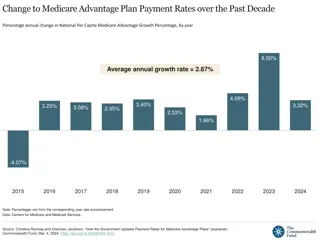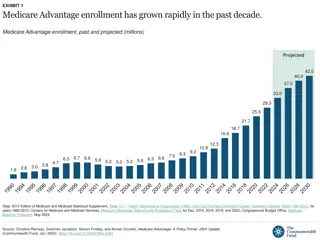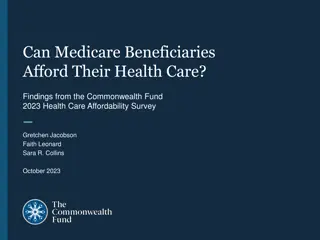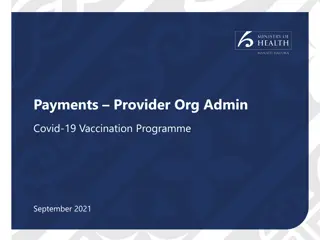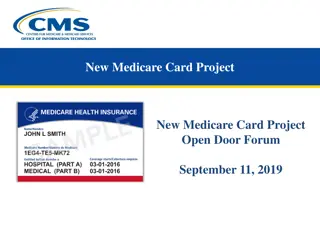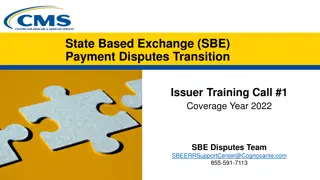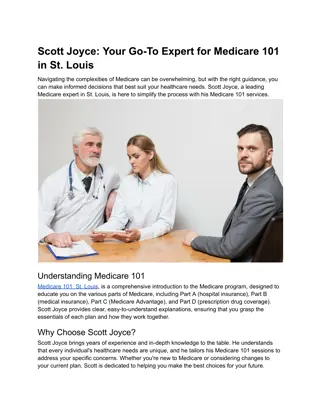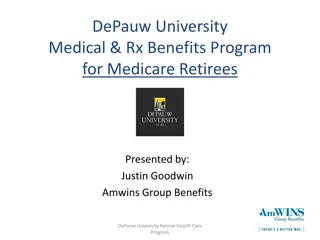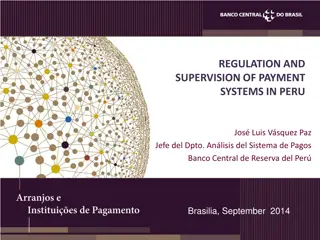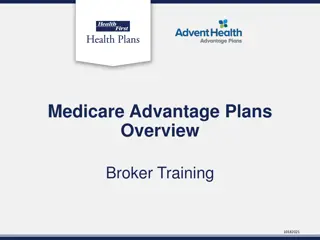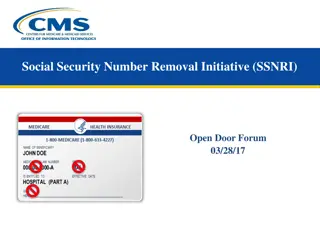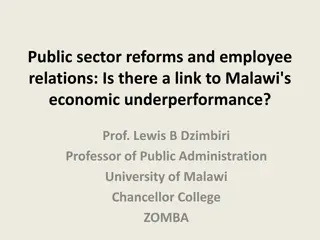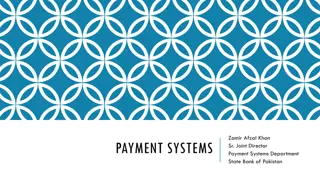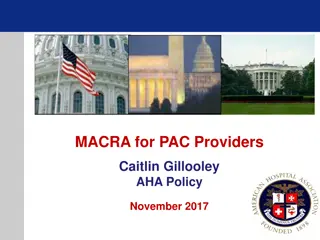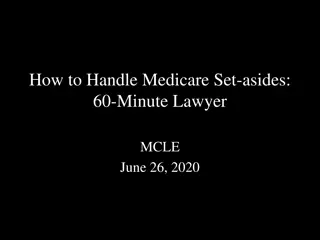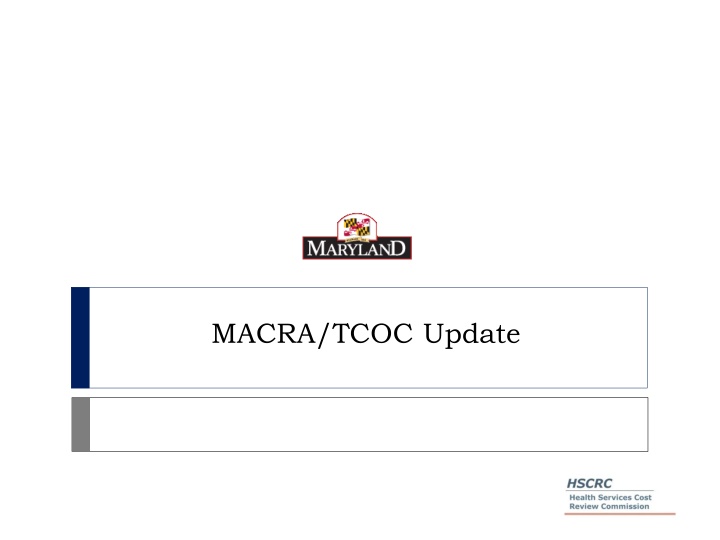
MACRA: Reforms in Medicare Payment Systems
MACRA, the Medicare Access and CHIP Reauthorization Act of 2015, brought significant changes to Medicare payment systems. It repealed the SGR formula, introduced quality-driven payment systems, and established two tracks - MIPS and Advanced APMs. This act aims to reward quality improvements in healthcare services and shift towards value-based care.
Download Presentation

Please find below an Image/Link to download the presentation.
The content on the website is provided AS IS for your information and personal use only. It may not be sold, licensed, or shared on other websites without obtaining consent from the author. If you encounter any issues during the download, it is possible that the publisher has removed the file from their server.
You are allowed to download the files provided on this website for personal or commercial use, subject to the condition that they are used lawfully. All files are the property of their respective owners.
The content on the website is provided AS IS for your information and personal use only. It may not be sold, licensed, or shared on other websites without obtaining consent from the author.
E N D
Presentation Transcript
maryland.gov MACRA/TCOC Update
Accelerating Movement via MACRA Medicare Access and CHIP Reauthorization Act of 2015 Signed into law in April 2015 MACRA Highlights Repeals use of the Sustainable Growth Rate (SGR) Formula Cut Medicare physician fees for all services if total physician spending exceeded a target, penalizing individuals who did control their costs Was volume-based- did not reward improvements in quality Replaces SGR with new quality-driven payment systems for providers 2
MACRA reform timeline (Medicare Access and CHIP Reauthorization Act of 2015) 2015 2016 2017 2018 2019 2020 2021 2022 2023 2024 2025 2026 Permanent repeal of SGR Updates in physician payments 0.5% (7/2015-2019) 0% (2020-2025) PQRS pay for reporting 2018 4% Meaningful Use Penalty (up to %) Value-based Payment Modifier TRACK 1 2017 -3.0% 1.0% 2.0% Merit-Based Incentive Payment System (MIPS) adjustments +/- 9% +/- 5% +/- 7% +/-4% Measurement period MIPS exceptional performance adjustment; 10% Medicare payment (2019-2024) 0.25% update Advanced APM participating providers exempt from MIPS; receive annual 5% bonus (2019-2024) TRACK 2 0.75% update Measurement period 3 Source: MACRA Summit
Track 1: Merit-Based Incentive Payment System (MIPS) MIPS is based on traditional Medicare FFS payments Performance Areas Streamlines 3 currently independent programs to work as one and to ease clinician burden. Adds a fourth component to promote ongoing improvement and innovation to clinical activities. Performance Area Description Previous Program Quality Preventive care, safety, etc PQRS and Quality Portion of the VBM Cost Medicare spending per beneficiary, etc Physician VBM Advancing Care information certified EHR technology Meaningful Use Improvement Activities Shared decision making, APM participation, patient safety, coordinating care, increasing access, etc None 4 Source: Summarized from https://www.cms.gov/Medicare/Quality-Initiatives-Patient-Assessment-Instruments/Value-Based- Programs/MACRA-MIPS-and-APMs/MACRA-Quality-Payment-Program-webinar-slides-10-26-16.pdf
Track 2: Advanced Alternative Payment Models (Advanced APMs) Advanced Alternative Payment Models (Advanced APMs) enable clinicians and practices to earn greater rewards for taking on some risk (or working with an AAPM Entity that takes risk) related to their patients outcomes Advanced APMs Entities Must: Use certified EHR technology, Pay based on MIPS comparable quality measures, and Bear more than nominal financial risk for losses 8% of the average estimated total Medicare Parts A and B revenues of participating APM Entities; OR 3% of the expected expenditures for which an APM Entity is responsible under the APM. Providers will receive +5% bonus incentive payment in 2019 for Advanced APM Participation in 2017 or 2018 if They receive 25% of their Medicare Part B payments through an Advanced APM; OR See 20% of their Medicare patients through an Advanced APM Thresholds increase in later years 5 Source: Summarized from https://www.cms.gov/Medicare/Quality-Initiatives-Patient-Assessment-Instruments/Value-Based- Programs/MACRA-MIPS-and-APMs/MACRA-Quality-Payment-Program-webinar-slides-10-26-16.pdf
Track 2: Advanced Alternative Payment Models (AAPMs) Eligible for 2017 Performance Year Comprehensive End Stage Renal Disease Care Model (Two- Sided Risk Arrangements) Comprehensive Primary Care Plus (CPC+) Shared Savings Program Track 3 Shared Savings Program Track 2 Oncology Care Model (Two-Sided Risk Arrangement) Next Generation ACO Model CMMI anticipates the following models will be Advanced APMs in the future: Advancing Care Coordination through Episode Payment Models Track 1 (CEHRT) Comprehensive Care for Joint Replacement (CJR) Payment Model New Voluntary Bundled Payment Model Vermont Medicare ACO Initiative (as part of the Vermont All-Payer ACO Model) ACO Track 1+ 6 Source: Summarized from https://www.cms.gov/Medicare/Quality-Initiatives-Patient-Assessment-Instruments/Value-Based- Programs/MACRA-MIPS-and-APMs/MACRA-Quality-Payment-Program-webinar-slides-10-26-16.pdf
Language Referencing Maryland in the MACRA final rule Final Rule on MACRA was released in October 2016 There was a specific clause in the final rule referencing the Maryland All-Payer Model and eligibility for MACRA in 2018: With new Advanced APMs expected to become available for participation in 2017 and 2018, including the Medicare ACO Track 1 Plus (1+), and anticipated amendments to reopen applications to modify anticipated amendments to reopen applications to modify current APMs, current APMs, such as the Maryland All such as the Maryland All- -Payer Model Comprehensive Care for Joint Replacement (CJR) model, we anticipate higher numbers of QPs approximately 70,000 to 120,000 in 2017 and 125,000 to 250,000 in 2018 in 2018. Payer Model and 7 Source: MACRA Final Rule p. 77013: https://www.gpo.gov/fdsys/pkg/FR-2016-11-04/pdf/2016-25240.pdf
MACRA-tizing the Maryland Model Progression Engaged physicians and other providers in aligned efforts Key strategies to have the All-Payer Model qualify as Advanced APM: CMS approved Care Redesign Programs (HCIP and CCIP) to link physicians to the All-Payer Model However, CMS requires hospital global revenues incorporate non- hospital Part B costs through incentives Concept Paper for a Value-Based Modifier (VBM) is being developed for CMS Other key approaches to have Advanced APMs in Maryland: ACOs with downside risk New statewide Comprehensive Primary Care Model (CPC+ design) New Dual Eligible ACOs 8
MACRA-tizing the Maryland Model for Care Redesign Amendment Programs Maryland All-Payer Model Alternative Payment Model (APM) Advanced APM Entities Maryland Hospitals Care Redesign Alignment Partnering Clinicians Qualifying APM Participant (QP) MACRA Test: QP Threshold Non Qualifying APM Participant Eligible clinicians for 2017 defined as physicians, nurse practitioners, physician assistants, certified nurse specialists, and CRNA 9
Determining individual physicians eligibility Calculations will depend on the structure of the TCOC value based modifier Claims run through TCOC measurement is the key: % ??????? =????????? ? ????????????? ???????? ?? ???????? ????????? ? ????? ??????????? ????? Or % ??????? = ????????? ? ???? ? ???????? ??? ????????????? ???????? ?? ???????? ????????? ? ????? ???? ? ???????? 10
Questions for TCOC Workgroup How to attribute Total Cost of Care (TCOC) to each hospital? Options: (1) Primary Service Area (PSA) that is, based on the zip codes each hospital has declared as theirs (2) 48 BPCI Episodes (3) All Episodes Plus Geography 11
Distribution of TCOC Under All Episodes (inner three circles) 12
Questions for TCOC Workgroup: Structuring VBM for Possible Payments and Incentives Once TCOC has been attributed to each hospital, what size of payment is appropriate? Although the VBM is proposed to satisfy CMMI requirements for financial responsibility on TCOC, should it also permit positive financial payments to hospitals? If so, how structured? Current goal is for VBM to be in place by January 2018 13


